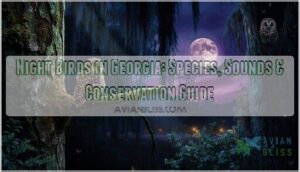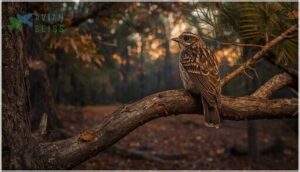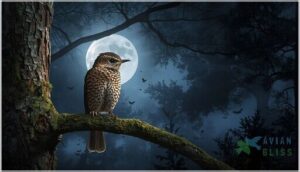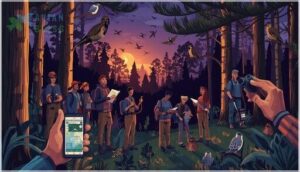This site is supported by our readers. We may earn a commission, at no cost to you, if you purchase through links.
Last summer, Chuck-will’s-widow populations crashed 58% since 1966, while Eastern Whip-poor-wills plummeted nearly 70% over the same period—yet most Georgians never noticed these phantom species slipping away under cover of darkness.
Night birds in Georgia inhabit a world invisible to daytime observers, their cryptic plumage and nocturnal habits making them some of the state’s most overlooked wildlife. From the insect-hawking Common Nighthawk to the territorial Barred Owl claiming suburban woodlots, these species have evolved striking adaptations for thriving after sunset.
Understanding which nocturnal birds call Georgia home, how to identify their distinctive sounds, and what threatens their survival can help you recognize—and protect—these essential but vanishing members of your local ecosystem.
Table Of Contents
Key Takeaways
- Georgia’s night birds—including Chuck-will’s-widows (58% decline since 1966) and Eastern Whip-poor-wills (nearly 70% decline)—are vanishing largely unnoticed due to habitat loss, pesticide impacts that eliminate insect prey, and urban hazards like light pollution and building collisions.
- You can identify these nocturnal species by learning their distinctive calls (the repetitive “chuck-will’s-widow” or three-syllable “whip-poor-will”) and recognizing their physical adaptations like cryptic plumage, oversized eyes, and wide mouths with bristles for catching insects mid-flight.
- These birds have evolved remarkable adaptations for nighttime survival, including eyes packed with light-gathering rod cells, enlarged ear openings for acoustic hunting, and specialized foraging strategies that depend on lunar cycles and open habitat with abundant flying insects.
- You can directly help protect Georgia’s declining night birds by joining the Nightjar Survey Network, participating in Lights Out Georgia during migration seasons, eliminating pesticide use in your yard, and supporting native plant restoration projects that provide essential insect-rich habitat.
Common Night Birds Found in Georgia
When the sun sets over Georgia, a unique cast of birds takes the stage. These nocturnal species have adapted to life in low light, using specialized features to hunt, navigate, and communicate after dark.
Let’s look at the night birds you’re most likely to encounter across the state.
Chuck-will’s-widow
You’ll recognize the Chuck-will’s-widow by its throaty, repetitive song echoing through Georgia’s open woodlands from spring into summer. This medium-sized nightjar species relies on camouflage techniques and oversized eyes to hunt insects at dawn and dusk. Habitat preferences include pine and oak-hickory forests with clearings. The bird’s cryptic dead-leaf pattern aids in its camouflage.
Unfortunately, population decline—nearly 58% since 1966—has made Chuck-will’s-widow conservation a priority, with migration patterns and nocturnal behavior still being studied.
Eastern Whip-poor-will
While the Chuck-will’s-widow prefers open woodlands, the Eastern Whippoorwill—another secretive nightjar—thrives in Georgia’s northern forests. You’ll hear its namesake call from continuous forest tracts interspersed with clearings.
Habitat preferences include oak and mixed hardwood-pine stands, where nesting success reaches 70% in ideal conditions. These birds are known to consume large, night-flying insects while in flight.
Unfortunately, this nocturnal bird species faces serious threats: populations have declined nearly 69% since 1970 due to habitat loss and pesticide impacts. Its conservation status demands acoustic monitoring of birds and expanded nightjar population monitoring to understand migratory patterns and reverse declines.
Common Nighthawk
The Common Nighthawk, another member of the nightjar family, hunts aerial insects over Georgia’s urban and open landscapes. You might spot this species on rooftop habitats, where it nests on gravel surfaces.
Migration patterns reveal an impressive journey—these birds travel up to 6,800 kilometers seasonally. Population monitoring shows a troubling 48% decline since 1966, driven by insecticide impact and urban collisions.
Nighthawk behavior includes foraging at dawn and dusk, when insects are most active.
Other Notable Nocturnal Species (e.g., Owls, Night-herons)
Beyond nightjar species, Georgia’s nocturnal birds include owls and night-herons with distinct behaviors. Barred owls thrive in suburban settings with territory sizes of 210–910 acres, while great horned owls adapt from wetlands to urban parks. Eastern screech-owls are Georgia’s most common owl, nesting in cavities with home ranges as small as 10–15 acres.
Black-crowned and yellow-crowned night-herons inhabit coastal wetlands year-round, their conservation status remaining stable.
Identifying Night Birds by Sight and Sound
Spotting night birds in Georgia takes a combination of patience and attention to detail. These birds blend seamlessly into their surroundings, so you’ll need to rely on both visual cues and their distinctive calls to identify them.
Here’s what to look and listen for when tracking down these elusive species.
Physical Characteristics of Night Birds
If you’ve ever tried spotting nocturnal birds in low light, you know their physical traits make all the difference. Night birds in Georgia share key adaptations that help you identify these elusive avian species:
- Plumage camouflage: Mottled browns, grays, and blacks blend seamlessly with bark and leaf litter
- Sensory adaptations: Oversized eyes gather maximum light for nighttime vision
- Bill morphology: Nightjar species have tiny bills but exceptionally wide mouths with stiff bristles
- Flight mechanics: Long, pointed wings enable silent, agile pursuit of insects
- Size comparison: Chuck-will’s-widows (11–13 in) dwarf smaller Whip-poor-wills (8.7–10.6 in)
Distinctive Calls and Songs
When you hear a rolling, seemingly endless “chuck-will’s-widow” echoing through Georgia’s night, you’re experiencing one of nature’s most distinctive vocal performances. Call identification relies on acoustic monitoring to capture seasonal patterns in nocturnal bird calls, from the sharp three-syllable whip-poor-will to the Common Nighthawk’s nasal “peent.
Field recording of birds reveals fascinating song variations—Chuckwillswidow song sessions may include over 1,000 consecutive repetitions, demonstrating striking vocal communication strategies.
Challenges of Nighttime Observation
Why does studying night birds feel like tackling an obstacle course? Weather constraints like fog and wind mask nocturnal bird calls, while light pollution in cities such as Atlanta disorients migrants and complicates observation. Observer safety concerns in dense terrain further limit survey opportunities.
Even with field recording technology, you’ll face acoustic limitations:
- Autonomous Recording Units (ARUs) require extensive data analysis
- Overlapping calls challenge species identification
- Brief survey windows miss critical activity periods
Acoustic monitoring helps, but gaps remain.
Nocturnal Adaptations and Behaviors
Night birds like the Chuck-will’s-widow and Eastern Whip-poor-will have evolved striking traits that let them thrive when most other birds are asleep. These adaptations aren’t just interesting—they’re what make nighttime hunting possible in low-light conditions.
Let’s look at the key features that help these birds navigate, hunt, and survive after dark.
Enhanced Vision and Hearing
How do Georgia’s night birds navigate total darkness? They don’t—they rely on remarkable eye anatomy and hearing structures. You’ll find their eyes packed with rod cells and reflective layers that boost moonlight, while enlarged ear openings pinpoint prey through sound alone.
These sensory adaptations evolved for natural light cycles, making light pollution a serious threat to nocturnal bird behavior that acoustic monitoring with Autonomous Recording Units helps researchers track.
Nighttime Foraging Strategies
You’ll see Georgia’s aerial insectivores employ a “hawking” technique—flying low over open ground, mouths wide, capturing insect prey mid-flight. Lunar influence drives foraging patterns:
- Moths and beetles fill their diet during moonlit nights
- Rictal bristles around beaks funnel food efficiently
- Light pollution disrupts natural insect hunting rhythms
Open pine forests and grasslands offer prime habitat preferences, where prescribed burning boosts nocturnal bird behavior and foraging success despite pesticide impacts reducing prey availability.
Migratory and Seasonal Patterns
When does nocturnal migration peak across Georgia’s skies? You’ll witness the heaviest movement between early September and late October, when up to 10.6 million migratory birds pass overhead in a single night. Chuck-will’s-widows and whip-poor-wills depart for warmer climates during winter, while spring migration timing brings breeding season arrivals, peaking around May 1.
Migratory bird behavior shifts with the seasons, as population shifts reshape Georgia’s nocturnal soundscape through bird migration cycles.
| Migration Period | Flight Altitudes | Peak Species Composition |
|---|---|---|
| Sept–Oct (Fall) | 1,000–10,000 feet | Nightjars, warblers, thrushes |
| March–May (Spring) | Variable by weather | 35+ warbler species statewide |
| Peak nights | Mid-range preferred | 900M+ birds Aug–Nov passage |
| Post-sunset hours | Wind-dependent | Mixed flocks, nocturnal hazards increased |
Conservation Challenges Facing Georgia’s Night Birds
Georgia’s night birds face mounting pressures that threaten their survival across the state. From disappearing habitat to human-made hazards, these nocturnal species are fighting an uphill battle.
Let’s look at the key challenges putting them at risk.
Habitat Loss and Fragmentation
Over the last 50 years, habitat loss has carved away roughly 63% of Georgia’s Chuck-will’s-widow population and 70% of Eastern Whip-poor-wills. Forest conversion to farmland and development drives this fragmentation, leaving isolated patches that can’t support healthy breeding. You’ll find these consequences everywhere:
Over the last 50 years, habitat loss has carved away roughly 63% of Georgia’s Chuck-will’s-widow population and 70% of Eastern Whip-poor-wills
- Edge effects expose nests to predators and weather extremes
- Small patch size reduces fledgling survival rates dramatically
- Lost connectivity disrupts foraging and migration routes
- Missing corridors prevent genetic exchange between populations
Forest management and habitat restoration offer paths forward.
Pesticide and Pollution Impacts
Beyond lost forests, you face another silent threat: chemicals coursing through Georgia’s night birds. Pesticide exposure and heavy metals strike aerial insectivores hard, poisoning their insect prey and collapsing food webs. Studies link organophosphates to over 9,000 U.S. bird deaths, while chronic exposure shrinks chick size and weakens reproductive success. Even low doses alter foraging behavior, compounding population crashes.
| Pollution Source | Direct Impact | Indirect Impact |
|---|---|---|
| Organophosphate pesticides | Immediate poisoning (9,000+ deaths documented) | Reduced insect populations collapse food supply |
| Agricultural chemicals | Sublethal toxicity weakens adults | Smaller offspring, lower survival rates |
| Heavy metals (Pb, Cd) | Bioaccumulation in tissues | Impaired reproduction, reduced nestling growth |
| Indiscriminate spraying | Mass mortality events in Georgia | 93% of studies show negative bird population effects |
| Atmospheric deposition | Feather contamination reflects exposure | Behavioral changes reduce foraging efficiency |
Pollution mitigation and integrated pest management offer your best routes toward recovery.
Urban Hazards and Collisions
Georgia’s cities place your night birds in a deadly maze. Atlanta ranks fourth for fall migration collisions, killing thousands yearly—over 4,400 documented since 2015 across 137 species.
Light pollution disorients nocturnal travelers, while reflective glass and vehicle strikes compound the toll.
Building design and mitigation efforts like Lights Out Georgia offer hope, reducing collision rates where communities dim lights during peak migration patterns.
Population Declines and Data Gaps
But you can’t protect what you can’t measure. Chuck-will’s-widow populations have dropped 58% since 1966, and Eastern Whip-poor-wills declined nearly 70% over fifty years—yet these data deficient species remain poorly understood.
Wildlife monitoring relies on brief annual surveys that miss most nocturnal activity. Habitat impacts, pesticide effects, and research challenges leave conservation decisions guessing at declining bird populations‘ true scope.
Community Science and Conservation Efforts
You don’t need a PhD to help Georgia’s nightjars—you just need to care and show up. Citizen scientists across the state are already making a real difference through surveys, recordings, and habitat work.
Here’s how you can join the effort and contribute to protecting these declining species.
Nightjar Survey Network Participation
You can join the Nightjar Survey Network as a volunteer, completing one annual survey along a nine-mile route with ten listening stops. Each stop requires a six-minute period to document Chuck-will’s-widow, Eastern Whip-poor-will, and Common Nighthawk presence.
Data standards include clear weather and moon phases above 50% illumination.
Your community science contributions directly inform conservation outcomes and reveal population impact trends for these declining nocturnal species.
Acoustic Monitoring and Field Recordings
Recording night birds with field recorders and Autonomous Recording Units (ARUs) like AudioMoth helps you capture sounds you’d miss during standard surveys. These devices sit on private lands for approximately six weeks, monitoring dusk-to-dawn activity with detection rates above 70%.
- ARU deployment covers at least 15 sites statewide in 2024
- Survey duration aligns with peak vocal periods
- Data sharing with conservation partners informs habitat influences on nocturnal species
Habitat Restoration Initiatives
Across Georgia, grassland restoration, wetland enhancement, and private lands projects are reversing habitat loss and degradation through native plant initiatives and ecosystem restoration.
Urban greenery efforts, such as the reinvigorated pollinator garden at Island Ford, and large-scale meadow work at Laverlea Preserve, where 11 acres of fallow pasture became native grassland, exemplify these initiatives. Community engagement is at the heart of these habitat management strategies, with over 100 volunteers planting 15,000 native grasses on Jekyll Island and restoring 19 acres at Wilburn Farm.
| Project Type | Example Site |
|---|---|
| Grassland Restoration | Laverlea Preserve (11 acres) |
| Wetland Enhancement | Lyon Farm, South River Watershed |
| Private Lands | 10 properties with thinning & burns |
| Urban Greenery | Island Ford pollinator garden |
How Residents Can Help Protect Night Birds
You can make a real difference for nocturnal birds right from your backyard. Join Lights Out Georgia to reduce lighting during migration, apply visible patterns to glass for window safety, and avoid pesticides that harm insect prey.
Citizen science initiatives like the Nightjar Survey Network need your observations, while the Habitat Stewardship Program backs native plant initiatives on private lands, creating safer spaces for night birds statewide.
Frequently Asked Questions (FAQs)
What do night birds eat in Georgia?
You might be surprised that night birds can swallow small warblers whole, but insects like moths and beetles make up their primary diet.
These aerial insectivores hunt at dusk using specialized bristles.
When is the best time to hear nightjars?
You’ll hear nightjars best late spring through early summer, around dusk and dawn. Peak Vocalization happens on bright, moonlit nights when Lunar Influence boosts calling activity.
Weather Factors matter—choose calm, clear evenings for best listening near suitable Habitat Proximity.
Are night birds protected by state law?
Like a safety net woven from statutes, Georgia’s wildlife laws protect all wild birds—including nightjars and night-herons—from hunting and disturbance. However, enforcement challenges persist, especially as habitat loss and legal loopholes complicate conservation efforts statewide.
How long do nightjars typically live?
Nightjars generally live around four years in the wild, though maximum age can reach twelve years. Adult annual survival rates hover near 70%, and you’ll find most reach breeding age by their first year.
Do night birds nest on the ground?
Straight to the forest floor—yes, nightjars lay eggs directly on leaf litter or bare ground without building nests. Their camouflage protects them from predator risks, though habitat disturbance and urban nesting challenges threaten these ground birds.
Conclusion
The same darkness that once concealed thriving populations of night birds in Georgia now hides their alarming decline. Your backyard feeders attract cardinals by day, but the Chuck-will’s-widows that once serenaded your summer evenings may never return without intervention.
Join a nightjar survey, reduce pesticide use, or simply turn off unnecessary outdoor lighting—because protecting species you rarely see requires recognizing they’re disappearing before silence becomes permanent.
- https://saportareport.com/introducing-the-chuck-wills-widow-georgia-audubons-new-species-of-concern/thought-leadership/georgia-audubon/
- https://www.birdsgeorgia.org/chuck-wills-widow.html
- https://www.ajc.com/news/10-million-birds-soar-across-georgia-nightly-heres-why/BQPCTOS3RNF45AAGCELAK5GZSM/
- https://dashboard.birdcast.info/region/US-GA
- https://gffgrow.org/birding/












